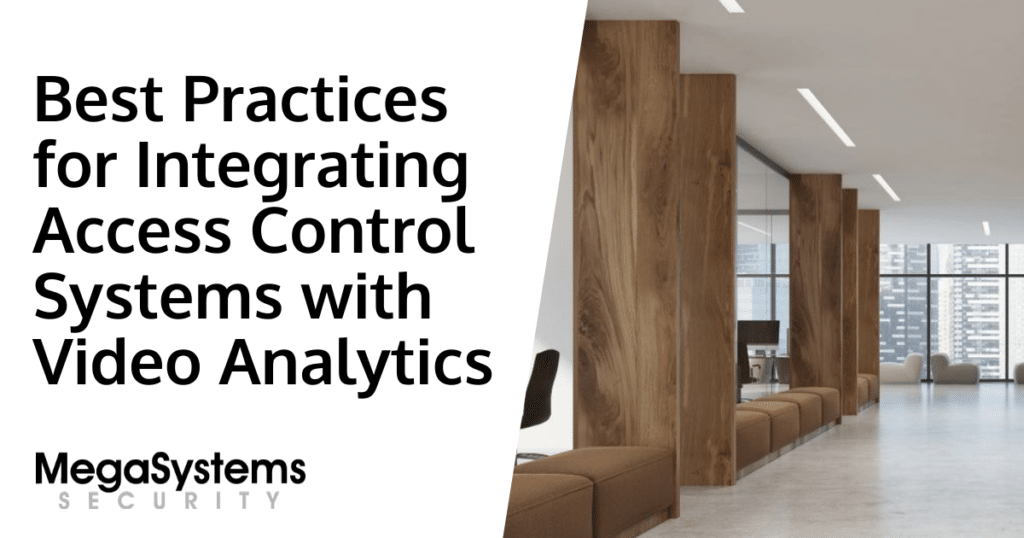Introduction to Access Control and Video Analytics Integration
The integration of access control systems with video analytics has become an essential advancement in modern security and surveillance. By seamlessly combining these two technologies, organizations benefit from enhanced safety, convenience, and reliability. Throughout this detailed discussion, every aspect of the integration is thoroughly explained so that even someone unfamiliar with the technology can understand its value and relevance. This article covers an in-depth overview of the entire process, including the history, key considerations in choosing components, installation tips, and the benefits and challenges associated with such setups.
Understanding the Core Technologies
Access Control Systems Explained
Access control systems are mechanisms designed to manage entry into designated areas, ensuring that only authorized personnel can gain access. The idea behind these systems is to regulate movement, maintain accountability, and provide an audit trail for entry events. This is achieved through various methods, such as keycards, biometric scans, or secure codes. Each method comes with distinct features and underlying technologies that have evolved with advances in microelectronics and digital communications.
When these systems work together with video analytics, the robust framework of entry management is considerably enhanced. The process of validating access is not just about granting or denying entry anymore, but also about recording human activity carefully, allowing for more sophisticated analysis with features that help in incident investigations and trend analysis. The integration of such technology in both residential and commercial sectors enhances overall security and creates a safer environment.
Video Analytics in Surveillance
Video analytics refers to the computerized interpretation of images captured by cameras as part of a surveillance system. Essentially, it enables real-time processing of video feeds to identify, classify, and track objects and events. This technology is particularly useful in identifying unusual behavior, potential security breaches, or abnormal patterns that might signify an impending threat.
In practice, the use of cameras combined with in-depth analytical techniques allows security personnel to monitor large areas with improved efficiency and precision. The sophistication of analytics systems means that even as thousands of frames are processed, the system can quickly alert operators, reducing the chances of delayed response. Moreover, these systems can be integrated into commercial buildings, government facilities, and even in smaller business setups to ensure that security is maintained around the clock.
Best Practices for a Successful Integration
Developing a Strategic Integration Plan
Before beginning the integration process, it is crucial to develop a robust strategy. This plan needs to address the specific security needs of the premises, identify the most suitable access control systems, and determine how video analytics will complement these systems. In doing so, one should carefully consider installation logistics, ensuring every component is positioned optimally. This deliberate strategy will lead to a seamless combination of technologies, ensuring that the advantages of each feature are fully harnessed.
This planning stage involves not just technical considerations but also an evaluation of historical security incidents, user behavior, and regulatory standards. These factors help in pinpointing which monitoring features are most critical and how to best implement them. The strategy should clearly define the roles of each constituent technology, such as cameras that provide the visual feed and processors that run analytic algorithms. In designing the integration plan, it is important to balance the complexity of systems with operational simplicity to avoid potential pitfalls during actual usage.
Understanding Installation Nuances
The importance of a professional installation cannot be overstated. Whether in a small office or a large commercial setup such as a building in Houston or a facility in tx, installing these systems requires expertise. Professional installers ensure that access control devices and surveillance cameras are placed in optimal locations, maximizing field of view and operational efficiency. Proper installation setups reduce blind spots, ensuring that every corner is adequately monitored and the integrity of the overall security strategy is maintained.
Additionally, the proper installation of the system includes configuring network connections and ensuring that data from cameras is securely transmitted. This is particularly important when handling sensitive personal or commercial information, where data breaches could have serious legal and financial ramifications. Installation is typically followed by rigorous testing and calibration to ensure that every sensor, node, and camera is communicating correctly with the central control unit.
Choosing the Right Components
When deciding on the components for integrating access control with video analytics, there are multiple factors to be considered. Firstly, it is essential to choose systems with high-quality cameras that capture clear images under various lighting conditions. High-resolution cameras provide detailed visuals that enhance the effectiveness of analytics, enabling the system to perform accurate real-time monitoring. It is also beneficial to opt for reliable systems that are known to work efficiently in both indoor and outdoor environments. For instance, some commercial installations in tx or Houston require ruggedized equipment able to withstand harsh weather conditions.
Besides the cameras, the analytical software itself must be up-to-date with the latest advancements in pattern recognition and threat detection. Furthermore, a system that allows for easy integration with other security measures like access control proves to be more robust. These components should be easily scalable, adaptable, and capable of integration on a larger network to handle the broader security demands of the organization.
Integration Techniques and Methods
Integrating access control systems with video analytics requires thoughtful consideration of the various communication interfaces and data streams involved. One of the common practices is to deploy a network that enables real-time data transfer between cameras and control panels. This network can be wired or wireless and must be secure to prevent unauthorized interceptions. In a typical setup, the cameras capture and send images to a central processing unit where algorithms analyze the data in real time. In parallel, the access control system authenticates individuals using biometric or proximity credentials.
It is the synergy between these techniques that generates the best fighting chance against potential threats. When a recognized individual is correctly authenticated, the system logs the time and identity while updating security logs. Conversely, if the video analytics identifies suspicious behavior around controlled entry points, the system alerts security personnel, who can then investigate further. The integration methods ensure that every component works not in isolation but as part of a unified whole, enhancing overall operational security.
Ensuring Continuous Compliance and Maintenance
Regular System Checks and Updates
After a successful installation and early integration, ensuring continuous compliance with operational standards is paramount. Routine system checks, software updates, and hardware maintenance prevent system failures. Detailed routine maintenance is crucial as it helps in promptly addressing minor issues before they become significant concerns. This maintenance schedule includes inspecting physical connections, recalibrating cameras, and reviewing logs generated by analytics.
Regular updates also allow the system to benefit from new features and improved analytics algorithms, thereby adapting to emerging patterns of security threats. The method of keeping the systems updated is integral to both coping with technological advancements and meeting regulatory standards. Highly responsive updates ensure that all features, such as access validation in commercial and high-traffic areas, are always working at optimal performance.
Balancing DIY and Professional Oversight
Many organizations consider whether to set up these advanced systems themselves or rely on professional help. While DIY projects might seem attractive for cost-saving reasons, the integration of sophisticated security and surveillance components is generally best handled by experts. Professionals not only come with a wealth of experience in installation and system configuration, but they also provide ongoing support and troubleshooting once the installation is complete.
For example, a small business in Houston looking to integrate advanced video analytics with access control might find the DIY approach manageable at first. However, as the system grows more complex—especially when incorporating elements like real-time threat detection and automated response—professional oversight becomes indispensable. Experts help navigate common challenges and ensure that all critical points are secured, thus delivering enduring value and reliability.
Evaluating Integration Outcomes and Future Trends
Assessing the Performance and Benefits
Once the access control and video analytics system is fully operational, it is essential to evaluate its performance continuously. Organizations must monitor operational efficiency, assess captured data, and understand how well the integration contributes to the overall mission of security. The benefits of such a comprehensive approach are manifold; they include improved threat detection, more accurate authentication, and quicker incident response times—all of which translate into greater safety for employees, assets, and visitors.
The integration allows better audit trails, easier investigations into any breaches, and a significant reduction in overall security risks. Additionally, when the system is augmented with advanced cameras and real-time video analytics, it enables decision-makers to foresee potential issues and mitigate risks before they escalate into full-scale security breaches.
Identifying Future Trends and Innovations
As technology continues to evolve, the integrated approaches to security are also developing at a rapid pace. One emerging trend is the use of artificial intelligence to further improve the accuracy of video analytics, making it possible to predict and prevent incidents before they occur. Moreover, future systems are expected to offer even tighter integration with other smart-building features, such as energy management and automated alerts, thereby blending security with overall operational efficiency.
One can also expect trends towards more user-friendly interfaces and better data integration capabilities where data from multiple camera angles and sensors are amalgamated to provide a holistic view of the environment. These trends indicate a future where the boundaries between different types of systems become blurred as they work together harmoniously. For businesses and institutions in commercial sectors, especially those managing facilities in Houston or tx, staying ahead of these trends by investing in updatable systems is essential for long-term security and compliance.
Conclusion
Integrating access control systems with video analytics represents a significant leap forward in the realm of security and surveillance. In this comprehensive guide, every detail—from conceptual understanding and historical evolution to practical installation and future trends—has been discussed thoroughly, ensuring that even readers unfamiliar with the technology can now appreciate its complexity and benefits.
This integrated approach is more than just installing a camera or configuring a system; it entails a holistic strategy that safeguards premises, refines data analysis, and continuously adapts to emerging security challenges. With professional installation and regular maintenance, organizations in both commercial and residential domains can harness the full potential of access control combined with video analytics, creating environments that are safer and more responsive to the evolving demands of modern security.


